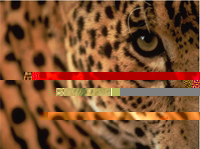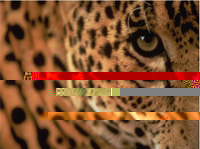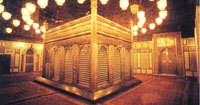
Taiz Zoo, a unique stronghold for the Arabian leopard [Archives:2008/1141/Last Page]
March 27 2008
 |
and Esomond Martin
For Yemen Times
For many years, there was a collection of animals outside the former Imam's Palace in Taiz. It consisted of mainly lions kept in tiny dark enclosures, the offspring of a pair of lions given to Yemen's last imam by Ethiopian Emperor Haile Selassie in 1950. In 1998, at the request of Taiz Governor Mohammed Al-Hijri, this collection received a new location, the Taiz Zoo.
A grassy, insect-infested area was chosen to construct the zoo on the outskirts of the city. It cost YR 33 million ($250,000), including an extension constructed in 2002. The new zoo site covers 10,000 square meters and has spaced to expand.
Taiz governorate's local council oversees the zoo through the Improvement and Cleaning Fund. The zoo's monthly budget is YR 3.5 million ($17,500), YR 1.2 million of which is for salaries and incentives for the 72 all-male employees, while the rest is for food and medicine.
The zoo is very popular, receiving many visitors, mostly on Fridays and during holidays.
The entry fee for Yemenis is YR 20 for children, YR 5 for adults and YR 150 for non-Yemenis. All funds go to the Improvement and Cleaning Fund, which in turn pays the zoo's budget. Taiz Zoo is open from 7 a.m. to 7 p.m. daily. A variety of animals can be seen, particularly those species indigenous to Yemen.
The zoo holds 22 of the rare Arabian subspecies of leopard, the largest number in captivity in the world. There are thought to be perhaps only 200 left in the wild in Arabia. Four of the zoo's leopards were captured wild in Yemen while the remainder of the Arabian leopards were born and successfully reared at the zoo.
A stud book is kept; however, none have yet been exchanged or transferred to other zoos.
Because wild mother leopards used to eat their cubs after birth, so in 2000, zoo staff adapted a cage (the type used to transport leopards), raising it off the ground and putting wide bars at its base through which the cubs can be removed. Once a pregnant female stops eating, usually a week before giving birth, she is placed in the cage within her enclosure.
During this time, five staff members attend to her needs, some even staying with her in the enclosure day and night. Immediately after the cubs are born, staff remove them safely through the bars during the daytime.
A whelping bitch then is brought in to feed the cubs.
This unique system has allowed a number of cubs to survive to adulthood.
Two captive-born leopards now are breeding and feeding their cubs unassisted. These cubs, now pre-adults, are wild and unapproachable and technically could be released into the wild.
The old zoo at the palace contained 10 lions when it closed down: Taiz governorate gave four to Sana'a Zoo and six were transferred to the new zoo. The numbers in Taiz now have built up to 31. Although one male born at the old zoo has fathered all of the offspring, there has been no sterilization of males.
Zoo staff hope there will be no more breeding due to fighting among the younger lions. Those that fight are kept away from each other.
One pre-adult cheetah from Africa was brought to the zoo via Jeddah, Saudi Arabia in November 2006.
The zoo also currently contains one tortoise and 20 terrapins.
All of the snakes at Taiz Zoo died because the funds their keeper used to pay children to collect lizards to feed them stopped and the keeper then left in dismay. A well-run and financed reptile house is needed and once this is built, the new keeper should visit Sana'a Zoo to learn how to feed snakes without relying on food/animals caught in the wild.
A veterinarian visits Taiz Zoo three hours every afternoon assisted by the zoo's dedicated full-time zoologist Mohammed Al-Shaifi. They have a small clinic with only a microscope and a centrifuge, but no laboratory or operating theater, so operations take place on the rough concrete ground of the clinic.
Due to limited medical facilities and drugs, it's not surprising that the death rate for many animals is high. Additionally, because there's no incubator, many small mammals die of cold and wet due to poor caging and limited medical care, so turnover is rapid.
Animal food and water
Taiz Zoo requires a steady funding source for food and a larger budget to feed its growing animal population. For example, lions eat 100 kilograms of meat a day, while leopards and wolves require 60 kilograms per day. Donkey meat usually is provided, but sometimes beef, lamb or camel meat is used.
Because funds sometimes are lacking, zoo staff fear that the facility easily could collapse if food supplies can't be regularly purchased. For this reason, the animals are fed mainly cheap vegetables (carrots, cabbages, tomatoes, green peppers, potatoes and onions), but they need more fruit.
As is the case with the whole of Taiz governorate, the zoo also suffers a water shortage problem. Staff would like a dam built on the grounds to collect rainwater. There's no working vehicle at the zoo to transport food and water to the animals, so a pick-up truck is much needed. Currently, wheelbarrows are used for all transport, but these are slow, laborious and unsuitable for very large or heavy items.
Promotion needed
Although Taiz Zoo is described in both Arabic and English in the city's tourism brochure, it attracts very few Western tourists, despite the chance to see the rare Arabian leopard and other native animals.
Taiz needs to better advertise the zoo, for example, at hotels, because tourists very well may donate to it if they saw its dire needs. In order to improve its attraction, sections of the zoo could concentrate on Yemeni species for foreign visitors so they could learn about local animals that they are unlikely to see otherwise.
Although originally intended in the zoo's plan, there is no education center, which is needed to teach Yemenis about wildlife and conservation and to help them appreciate their wildlife heritage in one of the Arabian Peninsula's richest remaining regions for wildlife.
——
[archive-e:1141-v:18-y:2008-d:2008-03-27-p:lastpage]


